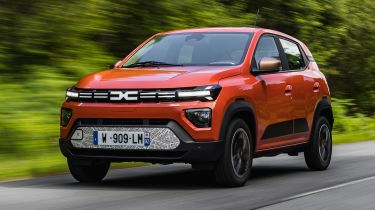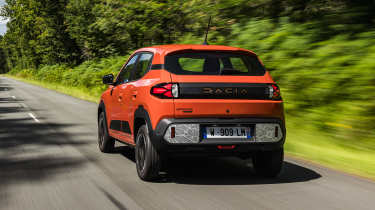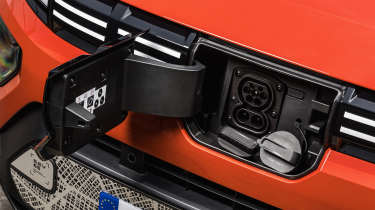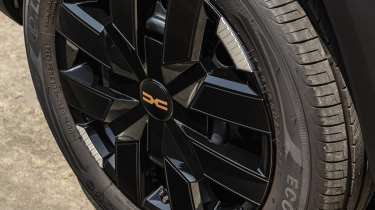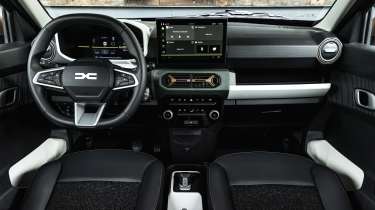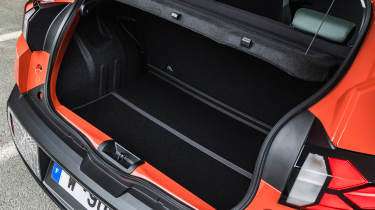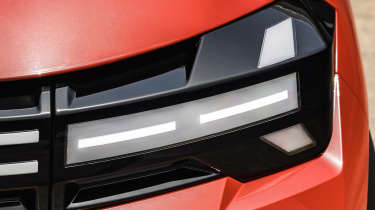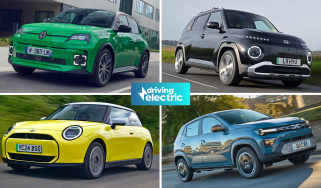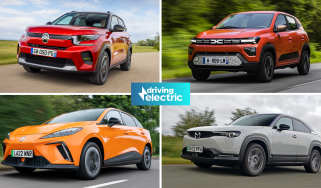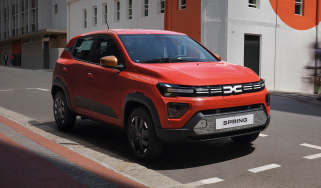Dacia Spring review
The Dacia Spring nails its brief as a low-cost, no-frills EV, but the competition is gradually closing in
Pros
- Britain’s cheapest EV (for now)
- Easy to drive and park
- Cheap to run
Cons
- Restrictive battery range
- One-star Euro NCAP rating
- Sluggish performance
| Range | Wallbox charge time | Rapid charge time |
| 140 miles | 5hrs (0-100%, 7kW) | 45 mins (20-80%, 30kW) |
Dacia Spring verdict
With so many new cars becoming larger and more tech-filled than ever before, the Dacia Spring goes in the opposite direction. This compact city car has a decent amount of basic kit and its tiny physique makes it easy and quite enjoyable to drive, so it’s an appealing yet simple package. This no-nonsense approach has allowed Dacia to price up its EV from just £14,995, making it the cheapest brand-new electric car in the UK. However, bigger rivals with bigger batteries are also starting to fall in price.
Details, specs and alternatives
The 2024 Dacia Spring is the first fully-electric Dacia to go on sale in the UK, and while it doesn’t feature a combustion engine of any kind, it does still follow the Romanian brand’s ethos of providing no-nonsense, budget-focussed motoring.
With its 26.8kWh battery returning up to 140 miles on the WLTP combined cycle, the Dacia Spring isn’t about to set any records for EV range. It certainly doesn’t set the world ablaze with its performance, either, with the most powerful model accelerating from 0-62mph in 13.7 seconds and then on to a top speed of just 78mph. Where the Spring does make serious waves, though, is with its price.
Think of the Dacia Spring as having just enough of what you need rather than any bells and whistles, and this little EV’s intended appeal starts to become clear. Due to its humble, no-frills nature, Dacia’s EV can be bought brand-new for a mere £14,995, which officially makes it the cheapest electric car in the UK at the time of writing.
The Spring’s 140-mile range is indeed a lot less than several rivals but, realistically, most city car buyers rarely exceed this kind of distance in a single day. Even if they do, it’ll only take around five hours to fully recharge the Dacia Spring from zero to 100% using a typical wallbox charger, as it supports 7kW AC charging.
If you want rapid DC charging, you’ll have to opt for the range-topping Spring 65. Its 30kW speed isn’t exactly quick by today’s standards, but this will still complete a 20% to 80% top-up in around 45 minutes.
The lack of luxuries or unnecessary gimmicks helps towards the Spring’s efficiency, too, as it has a kerb weight of less than one tonne. There’s even a decent amount of headroom inside for four passengers, although legroom in the back is a bit snug.
It’s not just the car itself that’s simple, either, as Dacia offers just two trim levels and two powertrain options with the Spring. Both versions are powered by the same 26.8kWh battery pack, but you can choose either the 45 variant with a 44bhp motor or the 65 with 64bhp on tap. The claimed 140-mile maximum range remains unchanged regardless of which version you choose.
Starting off the Spring line-up (and wearing that £14,995 price tag) is the 45 model in Expression trim, and even though this is the most budget-oriented Spring of them all, it’s still pretty well equipped. Standard kit includes air-conditioning, cruise control, automatic headlights and rear parking sensors. What this variant doesn’t have, though, is a proper infotainment system - you get a phone mount instead. If you want more power, you can also get the 65 in Expression trim, but this bumps up the starting price by £1,000.
At the top of the Dacia Spring range sits the Extreme trim, and this is only available with the 65 powertrain. Starting from around £17,000, this range-topper adds in a ten-inch touchscreen infotainment system with Android Auto and Apple CarPlay, all-round electric windows, a rear-view camera, a vehicle-to-load socket and 30kW DC rapid-charging capability.
With such a low starting price, there aren’t any fully-sized electric cars that can match the Dacia Spring at the moment. However, a number of supermini-sized rivals are starting to close the gap. The Citroen e-C3 is set to cost around £22,000 when it goes on sale in the UK, and this price will be closely matched by its Fiat Grande Panda sibling.
While this figure is still £7,000 more than the Dacia Spring, it is a clear sign that mainstream EVs are starting to move downwards on the pricing scale. Batteries are gradually becoming cheaper to manufacture, too, but for now, the Spring can be picked up for not that much more than a used Peugeot E-208, Fiat 500e or MINI Electric.
Range, battery size & charging
| Model | Range | Wallbox charge time | Rapid charge time |
| 45 | 140 miles | 5hrs (0-100%, 7kW) | N/A |
| 65 | 140 miles | 5hrs (0-100%, 7kW) | 45 mins (20-80%, 30kW) |
Regardless of your chosen trim or powertrain, the Dacia Spring has an official maximum battery range of 140 miles on the WLTP combined cycle.
You may initially be discouraged by this number, but it’s important to take a step back and think about just how many miles you actually cover on a daily basis. If you have to take on a regular long-distance motorway commute, the Spring probably won’t meet your needs. However, for those who only cover typical day-to-day journeys, particularly on urban roads, 140 miles should actually prove to be plenty.
Thanks to its sub-one tonne kerb weight, we found the Dacia Spring to be pretty efficient during testing, too. Our 65 test car returned a steady 4 miles/kWh, although we did have to make do with a somewhat leisurely pace.
As well as its lower weight and purchase price, there’s another key advantage to the Dacia Spring’s compact battery; it’s cheap and quick to recharge.
As it’s only 26.8kWh in size, the Spring’s battery pack only takes five hours to fully charge from a typical home wallbox unit. Rapid DC charging is only supported by the more powerful 65 variant, even though it’s powered by the same battery, and if you hook up to a 30kWh charging station this will complete a 20% to 80% top-up in around 45 minutes.
Running costs & insurance
A budget-focussed car would be pretty pointless if it wasn’t as cheap to run as it is to buy, so, unsurprisingly, the humble Dacia Spring isn’t about to bankrupt anyone when it comes to charging and taxing it.
A full charge of the 28.6kWh battery pack at a typical household rate of 30p per kWh should set you back by around £8, which is a bargain in itself. Spring owners will also benefit from zero VED road tax until April 2025, as well as exemption from emissions-based charges such as the London Ultra Low Emission Zone (ULEZ).
Technically the Dacia Spring does qualify for the 2% Benefit-in-Kind tax rate, but it may have limited appeal as a company car due to its relatively small battery range.
Performance, motor & drive
| Model | 0-62mph | Top speed | Driven wheels | Power |
| 45 | 19.1s | 78mph | Front | 44bhp |
| 65 | 13.7s | 78mph | Front | 64bhp |
The Dacia Spring is understated in its appearance, size, price and (you guessed it) it’s the same story with its performance, too. In keeping with its simplistic design, this little electric city car is the opposite of a speed machine. However, it is very easy and even rather enjoyable to drive due to its compact stature. Parking is a complete doddle.
To start up the Dacia Spring there’s no shiny starter button or glitzy fob, instead there’s a traditional key and ignition barrel. The handbrake is a regular lever, too, and there’s a simple toggle lever for selecting drive, neutral or reverse. It’s a very familiar layout for even the newest of EV drivers, not to mention one that’s cheaper to put together.
On the move, we found the Dacia Spring’s throttle to be very easy to modulate for an EV of this small size. While many lightweight electric cars are a bit overeager to chew up their front tyres, the Dacia pulls away in a pleasingly smooth fashion.
When driving within typical city traffic, there’s plenty of instant torque which allows reasonably brisk acceleration from 0 to 30mph. However, when we started hitting speeds that were any higher than this, the single motor’s modest power output quickly became obvious, as well as quite a lot of wind noise.
It’s lower-speed city streets where the Dacia Spring is best suited, though. The ride quality is pleasingly refined for such a barebones car, and it remains predictable in corners if you’re getting a little bit of a move on.
Our test car was a Spring 65, and this is the most powerful model with 64bhp and 113Nm being produced by its single front-mounted motor. This setup will take the Spring from 0-62mph in 13.7 seconds, and on to a top speed of 78mph.
The base model, meanwhile, is called the Spring 45. This is also powered by a single motor but it only produces 44bhp, although there is a little bit more torque at 125Nm. The result is a gruelling 19.1-second 0-62mph time, but the 78mph top speed remains the same when you eventually get there.
Interior, dashboard & infotainment
One of the areas where cost-cutting is usually most obvious on a budget car is the interior. While the Dacia Spring is never going to be classed as a luxury model, it’s a surprisingly pleasant and well-equipped place to be.
Although there are a few areas where Dacia has clearly scrimped and saved, such as the manual rear windows and analogue door mirrors, the base Expression trim does still come with some standard-fit creature comforts including air-conditioning, parking sensors and cruise control. There are also far fewer cheap-feeling plastics than we found in the previous model.
One key difference between the Expression and Expression trims, however, is that only the range-topper comes with a fully-fledged infotainment system. This is a 10.25-inch touchscreen setup with Apple CarPlay and Android Auto, and we found it easy enough to fathom. In place of this system, the Expression has a phone mount instead. Both variants get a seven-inch instrumentation display, which helps the Spring to feel a bit more sophisticated.
Boot space, seating & practicality
| Length | Width | Height | Boot space (seats up/down) |
| 3,701mm | 1,767mm | 1,485mm | 308/1,004 litres |
It may be a compact electric city car, but the Dacia Spring does offer an adequate amount of space for up to four passengers. There’s actually enough headroom for those over six-feet tall to sit comfortably, although rear legroom is a bit tight.
ISOFIX mounting points are fitted to the rear seats, but having a child seat fitted could make things very cramped for the passenger sitting next to them.
At the back, there’s 308 litres of boot space with the rear seats in place, which is the sort of capacity that’s usually found in larger superminis. In fact, the Citroen e-C3 only outsizes it by a mere two litres, while the Vauxhall Corsa Electric’s boot is actually smaller at just 267 litres.
Reliability & safety rating
This generation of the Dacia Spring is the first of its kind to be sold in the UK, but it’s actually a facelift of the previous generation car that was sold elsewhere in Europe. Unfortunately for Dacia, this means it’s tainted by the original model’s one-star Euro NCAP safety rating.
Dacia has made efforts to improve the safety of this refreshed model by throwing in a number of standard safety and driver-assistance features including six airbags, autonomous emergency braking with pedestrian detection, emergency brake assist, lane-keeping assist, lane departure warning, road sign recognition, speed alert and a driver monitoring system.
Regardless of this new tech, though, Dacia has admitted that it doesn’t expect Euro NCAP to change the Spring’s damning rating. One area where Renault’s Romanian counterpart has shined recently, though, is when it comes to reliability and customer satisfaction.
The Dacia Duster was rated as the best car to own in the 2024 Driver Power owner satisfaction survey, and it also scored strongly for reliability. Of course, the Dacia Spring is in no way directly related to the Duster mechanically, but having fewer moving parts does bode well for its dependability.
If things do go wrong, Dacia is selling the Spring with a 60,000-mile/three-year warranty plan. The battery is also covered by a separate 75,000-mile/eight-year plan with a guaranteed minimum capacity of 75%.

